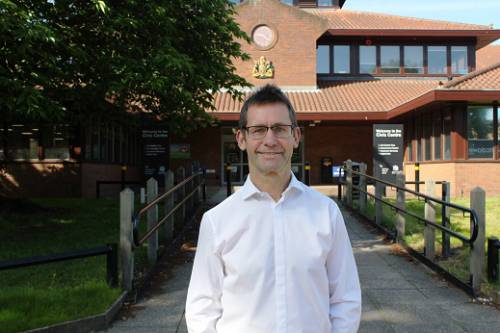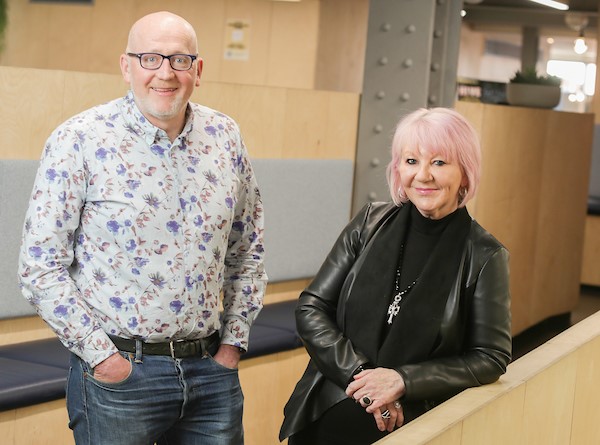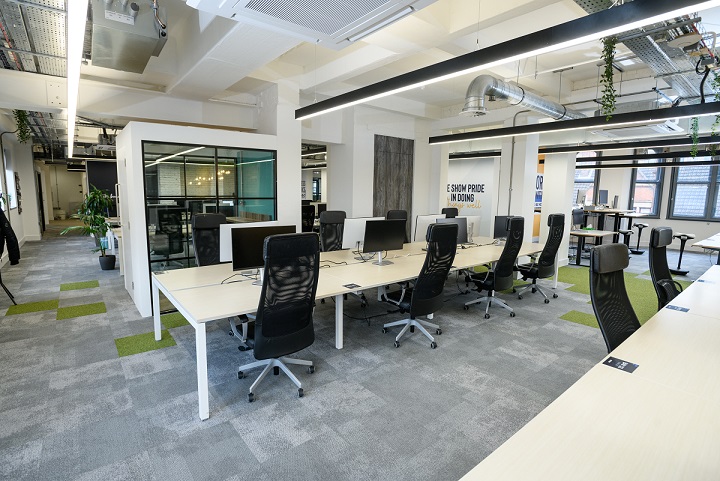As businesses across the country adapt their workspace to better suite changes in their business following COVID, specialist interior design and fit out company APSS looks at which office layout is best for different types of businesses.
It’s important staff feel motivated at work, after all, it’s where you spend the majority of the week and needs to be a place you can feel focused and comfortable.
The challenges of trying to get people into the office are rife. As some staff claim they will never return, especially with the current cost of a commute, many businesses are considering a redesign. When it comes to style, there’s a whole host of considerations to make, but a fundamental one is office layout.
Which layout is best for your office? One geared towards functionality, comfort, or productivity? It can be a minefield as everyone has their own preferences. Here’s a few thoughts about what might suit your business:
Open plan office: best for discussion, collaboration and freedom
For teams that work closely together, need easy collaboration to bounce ideas off each other, ask for help and combine efforts which helps a project all come together perfectly, an open-plan office could be your best bet. Open and airy, they give you the option of having free discourse among staff, and a more welcoming environment than everyone squirrelled away in boxes.
Cost-effective and easily adaptable, open-plan offices offer a great deal of flexibility. Have a new stream of employees joining? It’s easy to adapt and move desks, seating arrangements and teams. It’s also great for efficiency, the open conversations you can have across the room lead to details being confirmed faster, staff feel more updated and there’s a sense of camaraderie that’s missing from other layouts.
The only drawback is privacy. A sensitive conversation or meeting free of distractions needs to be held elsewhere and so partitioned meeting rooms or separate areas also need to be considered. Noise can also be an issue in open-plan offices, if teams that clash in terms of their approach are placed in close proximity, it can be detrimental to concentration and therefore productivity. Introducing noise-cancelling baffles or partitions can be a life-saver here and is something to consider when matching the style of work your business does to your office layout. A call centre, marketing company or creative office could benefit, whereas if dealing with sensitive information or highly technical work it might not be the most conducive environment.
Co-working space: best for being adaptable, modern and convenient
Having risen in popularity over the past few years, the co-working model is often a great option for new businesses or established businesses expanding into new markets or territories, it offers the formal feel of an office, but with a casual, convenient air.
Most co-working spaces by their very nature offer a mix of open plan and breakout rooms which are shared among a mix of freelancers, small business owners and more sizable operations. Often hotdesking and collaborative spaces are common, but with shared facilities such as printers, coffee machines, and breakout areas available.
This is often a great way to meet with other business owners and offers many ways to connect and work together. It also fosters a great feeling of community, meaning partnerships can be struck up and developed upon.
Co-working spaces offer more opportunities for creative design choices. With more adaptable spaces and designated areas for meetings or quick collaborations. It can make it feel more dynamic and welcoming than a standard setup.
Even those who own their own business can adopt the style of layout. More breakout spaces, casual and collaborative aspects folded into a standard open-plan layout can improve morale and make an office feel like more of a creative space rather than a collection of desks and meeting rooms. Meetings that are held in breakout areas tend to be less formal and can therefore take up much less time in the day.
Cluster office layout: best for focus, efficiency and belonging
Not as popular due to the space it takes up, the team cluster office layout does offer some distinct advantages. By seating teams working on the same projects together, it offers a more focused, smooth and inclusive environment for staff. Working collaboratively is one thing many who are in favour of returning to the office cite they miss, so this offers a hugely beneficial way of making that happen.
However, it can lead to cliques forming, with little to no contact with other teams other than via email or virtually, it can mean a hermetic seal of contact. It can also be a noisy, busy way to work, with little to no privacy amongst those seated in this way.
Hybrid office layout: best for flexibility and compromise
Much has been made of hybrid working in terms of the time spent at home and in the office, but in a bid to appeal to all employees, some businesses have transformed their spaces into hybrid, multi-faceted places of work. A combination of open plan, flexible, private and collaborative options, there’s a plethora of choices here for all personality types and takes in every taste. This not only gives existing staff a choice in the way they work, but also gives you the edge when it comes to attracting new candidates. In a world where candidates hold the power and can pick and choose where and how they want to work, this is key to understanding the market.
Having a varied and exciting place to work and collaborate is really important these days. The only drawbacks here are the disjointed nature of work and where it is done. Conversely, this can be solved by simply taking in new ways of working, meeting and focus time separated and specific spaces designated for each task.
There’s a challenge for a lot of businesses out there, it can go one of two ways. Embrace the challenge and dare to innovate, or watch your best staff and candidates simply up and run. An office is a reflection of your business, if it does not appeal, you might be in trouble.
For more information on how to make your office space work best for your business,
please visit the APSS website.












